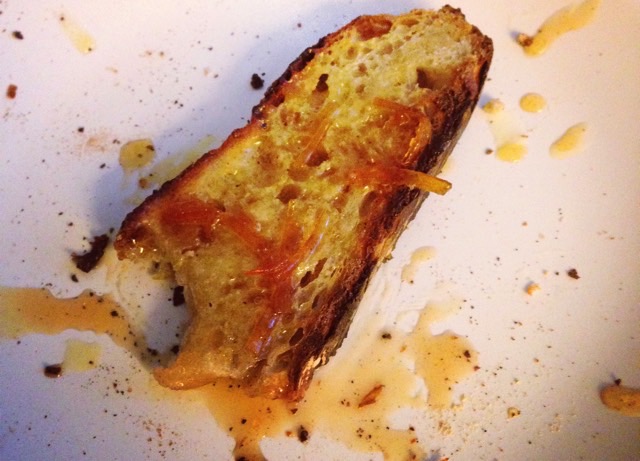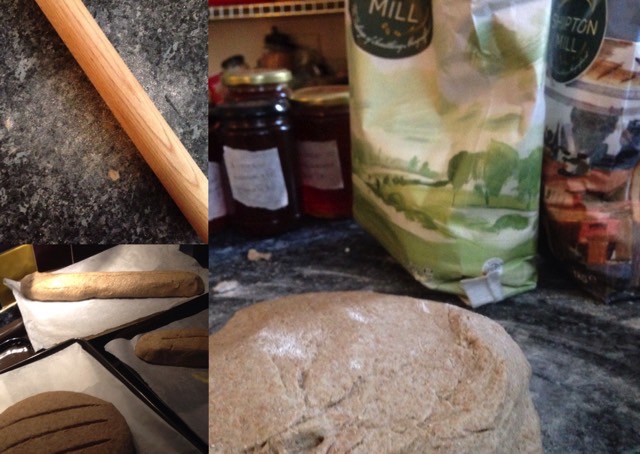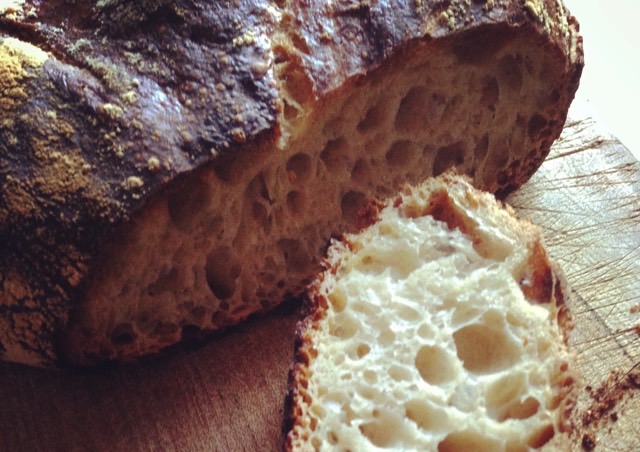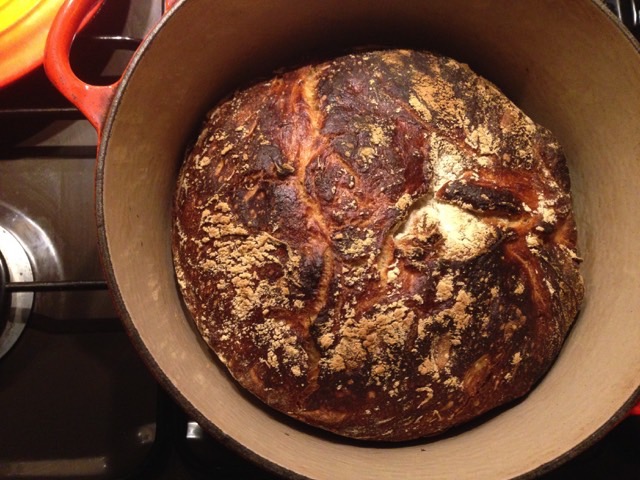More often than not nowadays, there is a smudge of flour somewhere on my person. Usually it’s on the cuffs on my favourite baggy blue cardigan. Sometimes it’s on my face. I’ve gone out with it splashed down my front, like a walking Rorschach test, and with handprints on my butt from where I’ve hastily brushed off the snowy white dust before dashing off a few lines on my laptop, or darting to the oven to check on whatever is currently making my kitchen smell like heaven.
You see, I’ve been baking a lot of bread.

sourdough toast and marmalade – both homemade – was a meal worth waiting for
I’ve made bagels and wheaten bread. Challah and cornbread. And one of my happiest achievements to date – sourdough.
Sourdough is a tricksome beast. The first time I tried, it was completely off. More like a dense wholemeal loaf than the chewy, crispy, airated bread I was aiming for. All was not lost, however; the brown doorstop made a pretty decent bread salad (once liberally doused in olive oil and introduced to the grill). The problem – I surmised, with my best Sherlockian pout – was the starter. The magical mix of flour, water and time that should give sourdough its rise and its character.

making the first, somewhat ill-fated loaf
But while the main components of starter are simple, what it creates is so much more than the sum of its parts. By giving flour and water some time to sit around, getting to know each other in just the right setting, you create something wild, primitive, epic. This is wild yeast; the stuff of sourdough’s bubbles and rise. But as my first attempt showed; not all are created equal. I’ve since rescued that first failed starter – it’s now a wholemeal/rye/white flour hybrid and makes for a very tasty loaf – and created a brand new one, following a new recipe. Just a tablespoon of this starter added to the dough mixture helps give the bread its signature airy bubbles.
I’d say I’ll walk you through the sourdough loaf recipe, but the folks at Kitchn have got this one sussed. I read a lot of recipes (dense, confusing recipes and long, confusing ones – sourdough is a much talked about topic) and this is a great one. It’s easy to follow and tells you why you’re doing what you’re doing, guiding you through every step. I’m on my sixth or so loaf and it just gets better. The glee at seeing a perfect sourdough loaf come out of the oven – made with nothing but flour, water and a little TLC – simply can’t be beat. Other than the Seville Orange Marmalade I’ve been making, it’s the best thing that’s come out of my kitchen in a long while.

the first ‘official’ loaf – would’ya look at those air bubbles?
I second what Emma Christensen at Kitchn says about getting yourself a cast iron Dutch oven to bake your bread in; it captures the steam and heat amazingly, helping you create a bakery-style loaf with next to no effort.

cast iron casserole dishes *with lids* are perfect for baking sourdough
A couple of things to note though:
- It’s worth scouting out a secondhand cast iron casserole dish for this as it does cause staining inside and out, which I have yet to remove, even using a paste of bicarb and water. So save your special cast iron dish for other recipes and dedicate a pre-loved one to this task instead. I found a great little oval Le Creuset for around £30 from ebay (for little loaves), and a whopper of a cast iron beast from a local charity shop for £6 (for big ‘uns).
- I was initially worried about heating an enamelled cast iron dish without anything in it (as suggested by the recipe, you preheat the empty dish in the oven). I’ve done a little research around this and the conclusion (thanks, internet) seems to be that it’s fine. I’m still a little skittish though, so I put my cast iron pot in a cold oven and then start preheating. This way it comes to temperature gradually – rather than risk putting it in at full whack (the recipe does require a hot, hot oven).
- Proving baskets, while a great addition to any baking kitchen, aren’t necessary. I use the flour-covered, tea towel-lined colander/mixing bowl method and it works great. Incidentally, proving the loaves in a round container even if you’re putting them in oval casseroles to bake is absolutely fine (they end up fitting the shape of your cast iron pot anyway). I also have yet to invest in a bench scraper – I’ve been shaping the loaves by hand and, while a little harder, it causes no ill effects!
- When it comes to keeping the starter toasty in my chilly Scottish flat, I tried the boiler cupboard and the airing cupboard, but the absolute winner has been the top of the fridge. Perfect starter conditions.
- Remember – once your starter is ready, it can be kept indefinitely in the fridge. Just feed the starter at least once a week (instructions on the Kitchn, as mentioned). If I’m not using it, I typically feed my starter in the evening and leave it at room temperature overnight (to give it a good head start) before popping it back in the artic regions of the fridge so it stays healthy and alive.
- But if you’re planning to use the starter, take it out of the fridge 2-3 days beforehand and feed it daily, keeping it in your room temp/toasty place. This will make sure it’s extra strong and potent and your loaf will have bubbles galore. Once you’ve used it to make your delicious, delicious bread, just pop it back in the fridge.

all the cool kids are doing it – check out Jake’s first amazing sourdough loaf
So what are you waiting for? If you get your starter going now, you can have home-baked bakery-quality sourdough in five days! That’s about time for a cast iron casserole to arrive from ebay… just sayin’.
Happy baking!

Hello! Sourdough is one of those things that I’ve always been a little intimidated to try. Yours looks just gorgeous. I think I’m going to have to give it a try. And I totally relate to having flour on your clothes, except mine is icing sugar (I’m a cake decorator)! I’ve gone a full day with sugar on my face, not knowing it’s there!
You should! I felt the same (about it being intimidating), but the recipe is easy to follow and the results are amazing! It’s a wonderfully slow, contemplative process. If I were you, I’d have a go at making the dough on a Saturday (get your starter started on, say, Monday), then you can leave your loaves to prove in the fridge overnight and bake them ready for breakfast on Sunday morning. There’s nothing like the smell of freshly baking bread! By the way – cake decorating sounds wonderful! G
Thanks for the tips! I’ll let you know how I get on!
Please do! Hope you enjoy it! G
Pingback: Peter Reinhart’s bagels | respectability & riot
Pingback: tahini toast with apple and cinnamon | respectability & riot